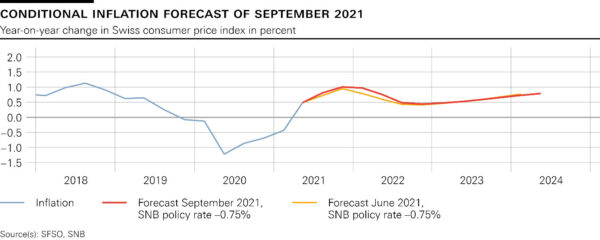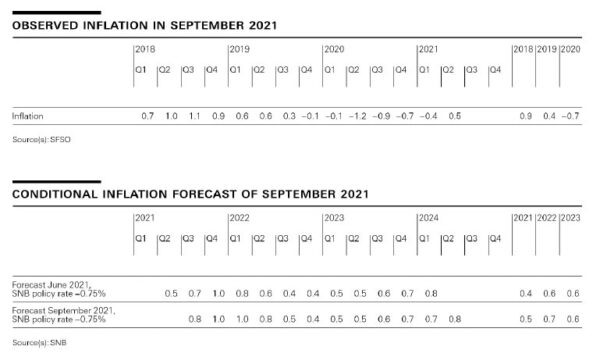The SNB is maintaining its expansionary monetary policy with a view to ensuring price stability and providing ongoing support to the Swiss economy in its recovery from the impact of the coronavirus pandemic. It is keeping the SNB policy rate and interest on sight deposits at the SNB at −0.75%, and remains willing to intervene in the foreign exchange market as necessary, in order to counter upward pressure on the Swiss franc. In so doing, it takes the overall currency situation into consideration. The Swiss franc remains highly valued.
The new conditional inflation forecast for 2021 and 2022 is slightly higher than in June (cf. chart 1). This is again primarily due to somewhat higher prices for oil products as well as for goods affected by supply bottlenecks. In the longer term, the inflation forecast is virtually unchanged compared with June. The new forecast stands at 0.5% for 2021, 0.7% for 2022, and 0.6% for 2023 (cf. table 1). The conditional inflation forecast is based on the assumption that the SNB policy rate remains at −0.75% over the entire forecast horizon.
The coronavirus pandemic, which is now in its second year, is continuing to shape the global economy. Although many countries have once again eased their containment measures since the spring, which contributed to strong global economic growth in the second quarter, infections have risen significantly again in numerous countries – including Switzerland – over the summer.
In its baseline scenario for the global economy, the SNB assumes that rigorous containment measures will no longer be necessary thanks to progress on the vaccination front. The current solid growth momentum is thus expected to continue in the coming quarters. Nonetheless, in many countries it will take some time for utilisation of production capacity to return to normal.
This scenario for the global economy is subject to high uncertainty, with risks on the upside and downside alike. On the one hand, the situation surrounding the pandemic could deteriorate, adversely affecting the economy once again. On the other hand, the economic policy measures introduced since the outbreak of the pandemic could support the recovery more strongly than anticipated in the baseline scenario.
In Switzerland, having declined slightly in the fourth quarter of 2020 and the first quarter of 2021, GDP increased strongly in the second quarter to just below its pre-crisis level. The situation on the labour market also continued to improve. Recently, however, economic momentum has slowed somewhat.
In its baseline scenario for Switzerland, the SNB anticipates a continuation of the economic recovery. This is also based on the assumption that the pandemic containment measures will not need to be tightened significantly again. Against this backdrop, the SNB expects GDP growth of around 3% for 2021. In June, the SNB had still been assuming higher growth. The downward revision is primarily attributable to the development of consumer-related industries such as the trade industry and hospitality, which performed less dynamically than expected.
GDP is likely to return to its pre-crisis level in the second half of the year. However, overall production capacity will remain underutilised for some time yet. Owing to the pandemic, the forecast for Switzerland, as for the global economy, remains subject to heightened uncertainty.
Mortgage lending and residential property prices have risen strongly in recent quarters. Overall, the vulnerability of the mortgage and real estate markets has increased further. The SNB regularly reassesses the need for the countercyclical capital buffer to be reactivated.















